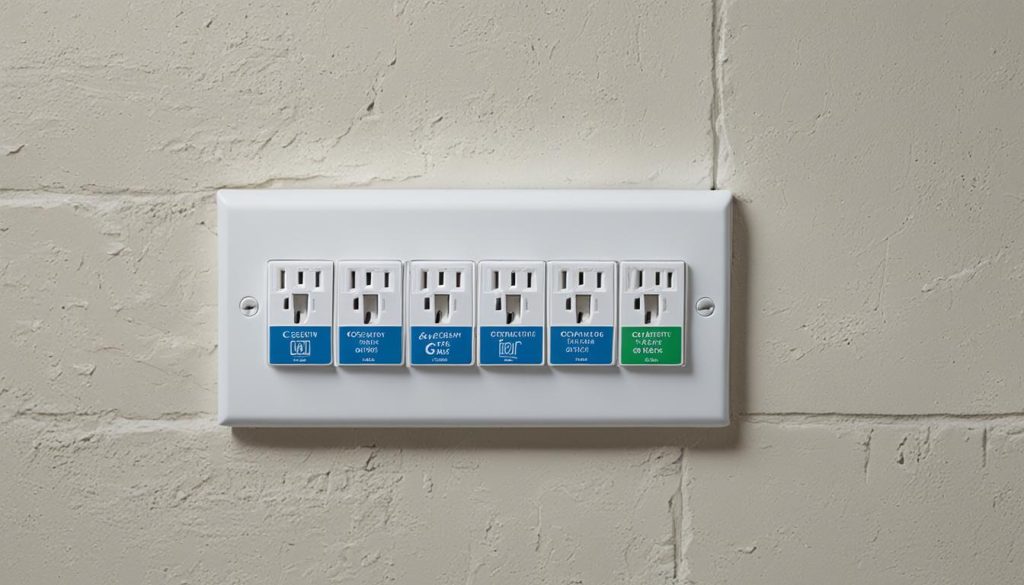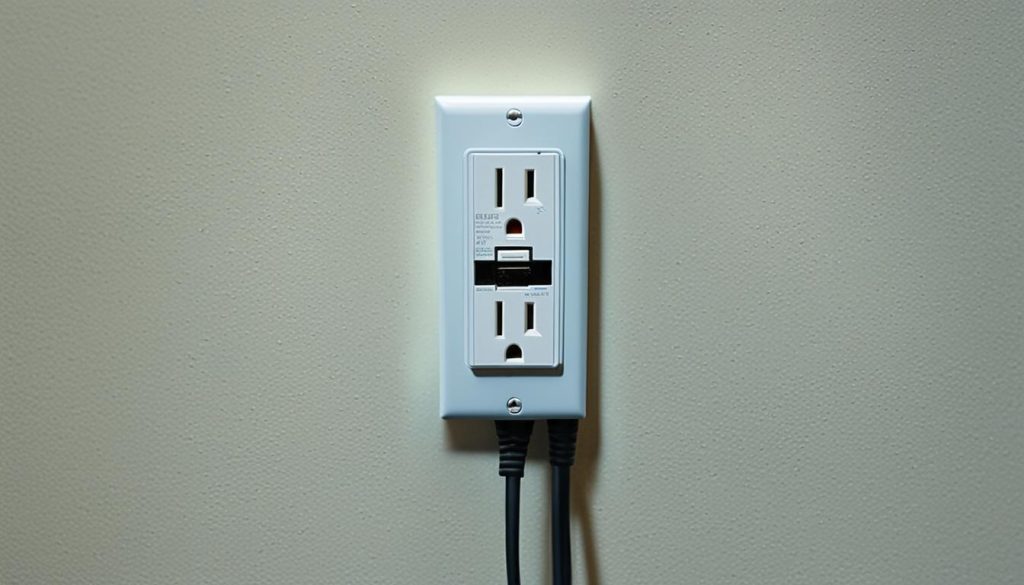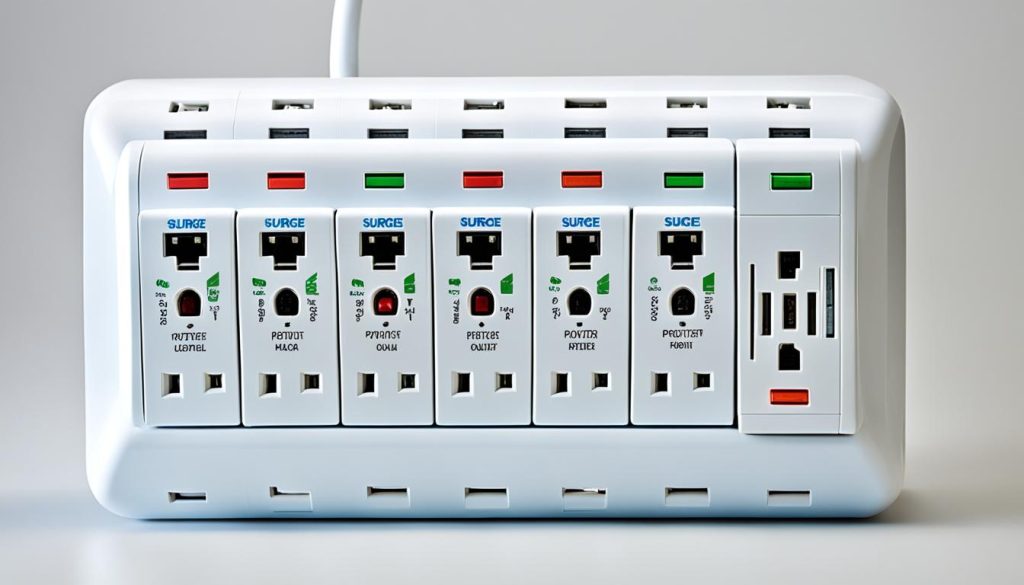Welcome to our guide on electrical safety and surge protection! It’s crucial to protect your home and loved ones from potential hazards like electrical shocks and power surges. One effective way to do this is by using a Ground Fault Circuit Interrupter (GFCI) with a surge protector. In this article, we’ll explore the benefits and considerations of using these devices together to ensure home electrical safety.
Key Takeaways:
- GFCI outlets protect against electrical shocks in wet or damp environments.
- Surge protectors safeguard electronic devices from voltage spikes and power surges.
- Plugging a surge protector into a GFCI outlet is generally not recommended due to safety concerns.
- Consider alternative solutions to ensure both electrical safety and surge protection.
- Exploring non-GFCI outlets with surge protectors or installing GFCI outlets in different locations are viable options.
Understanding Surge Protectors
Surge protectors are essential electrical devices that play a crucial role in safeguarding your valuable electronic equipment from voltage spikes and power surges. These surges, often caused by lightning strikes, utility switching, or electrical malfunctions, can cause significant damage to your electrical devices, leading to costly repairs or replacements.
Surge protectors work by diverting excess voltage away from your devices and sending it to the grounding wire, effectively protecting your electrical equipment. They act as a barrier that absorbs the sudden surge of voltage, preventing it from reaching your sensitive electronics.
Surge protectors come in various forms, including power strips with multiple outlets and built-in surge protection capabilities. These power strips offer the convenience of powering multiple devices simultaneously while providing surge protection for each connected device.
The Benefits of Surge Protectors:
- Prevent damage to electrical devices: Surge protectors shield your valuable electronics, such as computers, televisions, and gaming consoles, from harmful voltage spikes that could potentially fry their delicate circuitry.
- Extend the lifespan of your devices: By protecting your electrical devices from sudden voltage surges, surge protectors help prolong their lifespan and reduce the need for frequent repairs or replacements.
- Ensure safety and peace of mind: Surge protectors provide an added layer of safety by reducing the risk of electrical fires caused by power surges. This ensures your home or office remains secure, giving you peace of mind.
Investing in surge protectors is a wise decision to protect your valuable electronics from costly damage. With their ability to divert excess voltage and safeguard your devices, surge protectors are an essential component of any electrical system.
Choosing the Right Surge Protector:
When selecting a surge protector, it’s important to consider factors such as its joule rating, clamping voltage, and number of outlets. The joule rating determines how much energy the surge protector can absorb before it fails to provide protection, while the clamping voltage indicates the maximum voltage allowed to pass through to your devices. Additionally, considering the number of outlets you need and the type of devices you’ll be connecting will help you choose a surge protector that meets your specific requirements.
| Feature | Description |
|---|---|
| Joule Rating | The higher the joule rating, the better the surge protector can absorb excess voltage. Look for a surge protector with a joule rating of at least 1000 joules for optimal protection. |
| Clamping Voltage | The clamping voltage indicates the maximum voltage that the surge protector allows to pass through to your devices. Lower clamping voltage provides better protection. |
| Number of Outlets | Consider how many outlets you need for your devices and ensure that the surge protector has enough outlets to accommodate them. |
Choosing the right surge protector ensures that you have the appropriate level of protection for your electrical devices. Take the time to select a surge protector that meets your specific needs and provides optimal protection against power surges.
Understanding GFCI Outlets
GFCI outlets, short for Ground Fault Circuit Interrupter outlets, play a crucial role in protecting against electrical shocks, especially in wet or damp environments. They continuously monitor the electrical current flowing through them, promptly detecting any imbalances that could lead to potentially dangerous shocks.
GFCI outlets are commonly installed in:
- Kitchens
- Bathrooms
- Garages
- Outdoor locations

In these areas, the risk of electrical shocks is higher due to the presence of water or moisture. The rapid circuit interruption ability of GFCI outlets ensures immediate protection against shocks before they can cause harm.
By interrupting the electrical circuit, GFCI outlets prevent the flow of electrical current through a person or object that has come into contact with water or other conductive substances.
The effectiveness of GFCI outlets in wet environments relies on their ability to detect even small imbalances in the electrical current. This is achieved by measuring the current between the hot and neutral wires. If an imbalance greater than a certain threshold is detected, the GFCI outlet promptly interrupts the circuit, minimizing the risk of electrical shock.
Overall, GFCI outlets provide an essential layer of protection in areas where electrical safety is paramount. By installing GFCI outlets in kitchens, bathrooms, garages, and outdoor locations, you can significantly reduce the risk of electrical shocks and ensure the safety of yourself and your loved ones.
Can You Plug a Surge Protector into a GFCI Outlet?
While it is possible to plug a surge protector into a GFCI outlet, it is generally not recommended due to safety concerns. GFCI outlets are specifically designed to protect against electrical shocks, and their ability to detect electrical imbalances may be hindered when a surge protector is connected.
When a surge protector is plugged into a GFCI outlet, the GFCI’s ability to detect electrical imbalances may be compromised. This can reduce the level of protection against electrical shocks provided by the GFCI outlet. Additionally, a power surge experienced by the surge protector may trip the GFCI outlet, cutting off power to all connected devices.
Safety Concerns
Plugging a surge protector into a GFCI outlet introduces safety concerns as it can hinder the effectiveness of both devices. GFCI outlets are specifically designed to protect against electrical shocks in wet or damp environments, such as kitchens, bathrooms, garages, and outdoor locations. By plugging in a surge protector, the GFCI’s ability to detect electrical imbalances may be compromised, reducing its overall effectiveness in preventing electrical shocks.
Furthermore, a power surge experienced by the surge protector can potentially trip the GFCI outlet, resulting in a loss of power to all connected devices. This interruption can be inconvenient and potentially dangerous if certain devices rely on a constant power supply, such as medical equipment or alarm systems.
“When a surge protector is plugged into a GFCI outlet, it can compromise the safety features of both devices. It’s best to use them separately to ensure optimal protection against electrical shocks and power surges.”
Understanding Voltage Spikes and Electrical Current
Surge protectors are designed to safeguard electronic devices from voltage spikes and power surges. They divert excess voltage to the grounding wire, preventing the excess voltage from damaging connected equipment.
On the other hand, GFCI outlets continuously monitor the electrical current flowing through them. If there is an imbalance, such as current flowing through a person due to an electrical shock, the GFCI quickly interrupts the circuit, preventing the occurrence of potentially dangerous electrical shocks.
Alternatives to Plugging a Surge Protector into a GFCI Outlet
If you have a GFCI outlet and still require surge protection, there are alternatives to consider. One option is to use non-GFCI outlets with surge protectors in areas where electrical shocks are less likely, such as living rooms or bedrooms. This allows you to have surge protection without compromising the safety features of the GFCI outlet.
Another alternative is to install GFCI outlets in other locations without the need for surge protectors. This ensures both electrical safety and surge protection in specific areas, providing comprehensive coverage for your home.
Recommended Safety Measures
To ensure optimal electrical safety and surge protection, it is recommended to use surge protectors and GFCI outlets separately when possible. This allows each device to fulfill its intended purpose without compromising safety features.
Additionally, regularly inspect your surge protectors to ensure they are in good condition and still providing adequate protection. Replace surge protectors that show signs of wear or damage. For GFCI outlets, conduct routine tests to ensure they are functioning correctly by pressing the “Test” and “Reset” buttons.
| Pros of Plugging a Surge Protector into a GFCI Outlet | Cons of Plugging a Surge Protector into a GFCI Outlet |
|---|---|
|
|
In conclusion, while it is physically possible to plug a surge protector into a GFCI outlet, it is generally not recommended due to potential safety compromises. Understanding the purpose and functionality of both devices is crucial in ensuring optimal electrical safety and surge protection for your home.

Safety Considerations
When it comes to using a surge protector with a GFCI outlet, there are important safety considerations to be aware of. Plugging a surge protector into a GFCI outlet can potentially compromise the GFCI’s ability to detect electrical imbalances, which is crucial for protecting against electrical shocks. Additionally, it’s worth noting that a power surge experienced by the surge protector may cause the GFCI outlet to trip, resulting in a loss of power to all connected devices.
While both surge protectors and GFCI outlets play vital roles in electrical safety, their functionalities can conflict when used together. The surge protector diverts excess voltage to the grounding wire, safeguarding your electronic devices from power surges. On the other hand, the GFCI outlet continually monitors the electrical current to detect any imbalances and interrupt the circuit to prevent electrical shocks.
“Plugging a surge protector into a GFCI outlet can hinder the functionality of both devices and compromise electrical safety.”
It’s important to understand that a GFCI outlet’s primary purpose is to protect against electrical shocks in wet or damp locations, such as kitchens, bathrooms, garages, and outdoor areas. Plugging a surge protector into a GFCI outlet in these areas can potentially reduce the level of protection offered by the GFCI against electrical shocks.
Whether you’re considering using a surge protector with a GFCI outlet or not, it’s crucial to prioritize electrical safety. Exploring alternative solutions can help you strike a balance between surge protection and GFCI functionality. Some alternatives include:
- Using non-GFCI outlets with surge protectors in areas where the risk of electrical shocks is relatively low.
- Installing GFCI outlets in different locations to ensure both electrical safety and surge protection in specific areas.
By carefully considering your options and understanding the potential safety implications, you can make informed decisions when it comes to using surge protectors and GFCI outlets in your home.
Keep in Mind
It’s essential to remember that the safety considerations mentioned in this section are general guidelines. Specific situations may require expert advice or professional electrical assistance to ensure optimal safety and functionality. When in doubt, consulting a qualified electrician is always recommended.
Factors to Consider
When deciding whether to plug a surge protector into a GFCI outlet, there are several important factors to consider. By evaluating the surge protector’s ratings and specifications, understanding the load capacity of GFCI outlets, and exploring alternative solutions, you can make an informed decision that ensures both electrical safety and surge protection.
Surge Protector Ratings and Specifications
Before connecting a surge protector to a GFCI outlet, it is crucial to review its ratings and specifications. Pay attention to the surge protector’s voltage rating, energy absorption rating, and response time. Ensure that these specifications are compatible with GFCI circuits to optimize functionality.
Load Capacity of GFCI Outlets
GFCI outlets have a specific load capacity that should not be exceeded. Plugging in multiple high-power devices to a single GFCI outlet can overload it and potentially cause safety hazards. Therefore, it is essential to consider the load capacity and distribute the power usage among multiple outlets if necessary.
Exploring Alternative Solutions
If plugging a surge protector into a GFCI outlet poses safety concerns or is not feasible, there are alternative solutions to consider. One option is to use non-GFCI outlets with surge protectors in areas where electrical shocks are less likely to occur. Another solution is to install additional GFCI outlets in different locations, allowing for both electrical safety and surge protection in specific areas of your home.
By carefully considering these factors, you can ensure the compatibility of your surge protector with GFCI outlets, prevent overloading, and explore alternative solutions that meet your electrical safety and surge protection needs.

Alternatives to Plugging a Surge Protector into a GFCI Outlet
If you find yourself needing surge protection but your electrical setup includes a GFCI outlet, there are alternative options to consider. These alternatives allow you to prioritize both surge protection and electrical safety.
Using Non-GFCI Outlets with Surge Protectors
If you are in an area where the risk of electrical shocks is relatively low, you can opt to use non-GFCI outlets with surge protectors. By doing so, you can still provide surge protection for your electronic devices without compromising the safety features of the GFCI outlet. This option is particularly suitable for spaces that are not exposed to moisture, such as living rooms or offices.
Installing GFCI Outlets in Different Locations
Another option is to install GFCI outlets in different locations throughout your home or workspace. By strategically placing GFCI outlets, you can ensure electrical safety and surge protection in specific areas. This approach is beneficial for areas prone to moisture, such as kitchens, bathrooms, or outdoor locations.
It is essential to evaluate your specific electrical needs and consider the context when choosing between these alternatives. By addressing electrical safety and surge protection, you can safeguard your devices and ensure peace of mind.

Conclusion
When it comes to electrical safety and protecting against power surges, it is important to make informed decisions. While it might seem convenient to plug a surge protector into a GFCI outlet, it is generally not recommended due to potential safety compromises.
Plugging a surge protector into a GFCI outlet can hinder the functionality of both devices, compromising the ability of the GFCI outlet to detect electrical imbalances. This can reduce the level of protection against electrical shocks that the outlet provides.
To ensure optimal use of both devices while prioritizing electrical safety, it is advisable to explore alternative solutions. Consider using non-GFCI outlets with surge protectors in areas where the risk of electrical shocks is low. Alternatively, installing GFCI outlets in different locations can provide both electrical safety and surge protection in specific areas.
Remember, the goal is to safeguard your home and devices from power surges and electrical shocks. By making informed choices and understanding the capabilities of surge protectors and GFCI outlets, you can achieve optimal electrical safety for your home.
FAQ
Can I plug a surge protector into a GFCI outlet?
While it is physically possible, it is generally not recommended due to potential safety compromises.
What is the purpose of a surge protector?
Surge protectors safeguard electronic devices from voltage spikes and power surges by diverting excess voltage to the grounding wire.
What are GFCI outlets designed for?
GFCI outlets are specifically designed to protect against electrical shocks in wet or damp environments.
Why is it not recommended to plug a surge protector into a GFCI outlet?
Plugging a surge protector into a GFCI outlet can compromise the functionality of both devices and hinder electrical safety.
Are there any safety considerations when using a surge protector and GFCI outlet?
Yes, it’s important to consider the reduced level of protection against electrical shocks provided by the GFCI outlet when a surge protector is connected.
What factors should I consider when plugging a surge protector into a GFCI outlet?
It is important to consider the surge protector’s ratings and specifications to ensure compatibility with GFCI circuits. Additionally, the load capacity of GFCI outlets should be considered to avoid exceeding their capacity.
What are some alternatives to plugging a surge protector into a GFCI outlet?
Using non-GFCI outlets with surge protectors in areas where electrical shocks are less likely or installing GFCI outlets in different locations can be considered as alternatives.
What are the benefits of using GFCI outlets and surge protectors?
GFCI outlets protect against electrical shocks, while surge protectors safeguard devices from voltage spikes and power surges, providing both electrical safety and surge protection.


